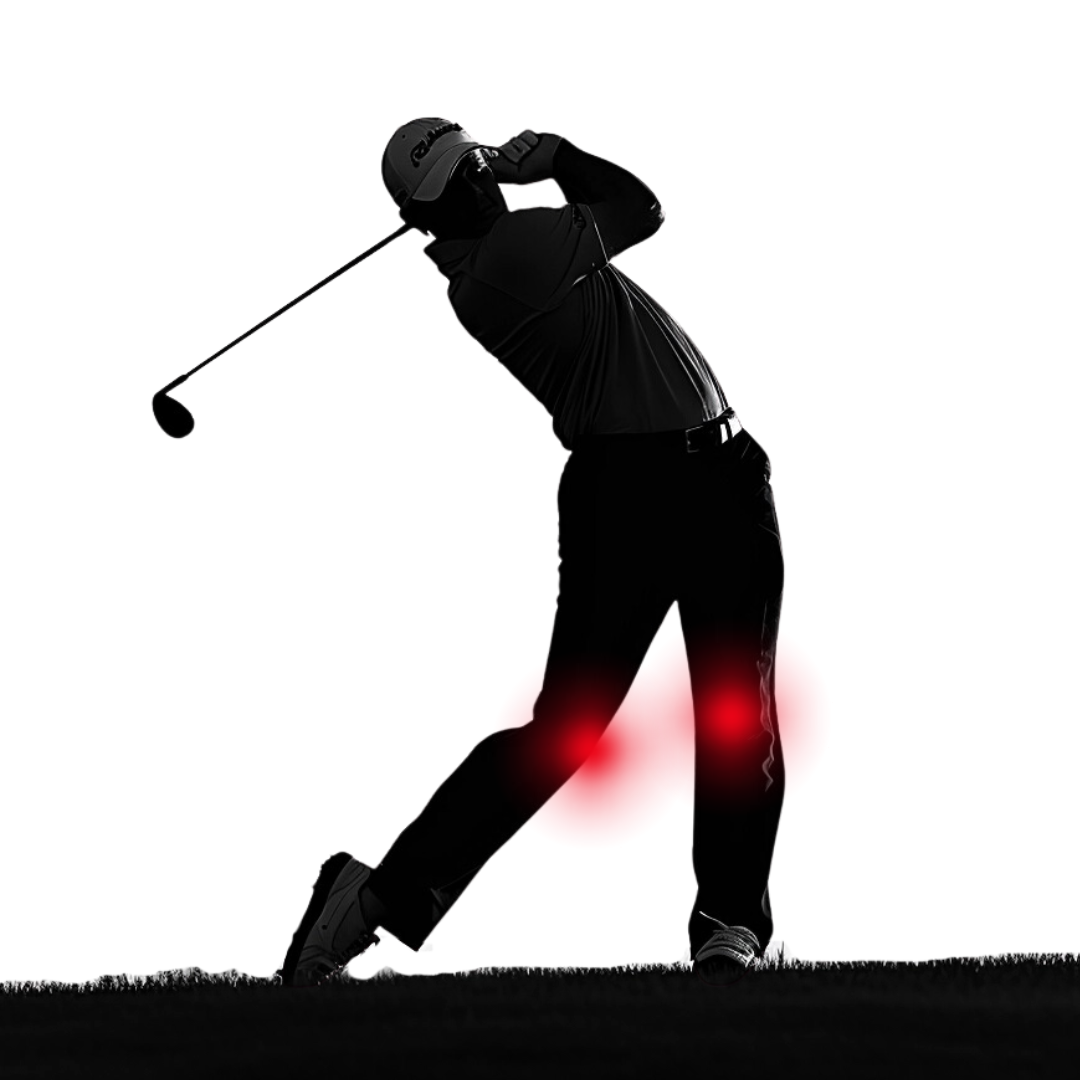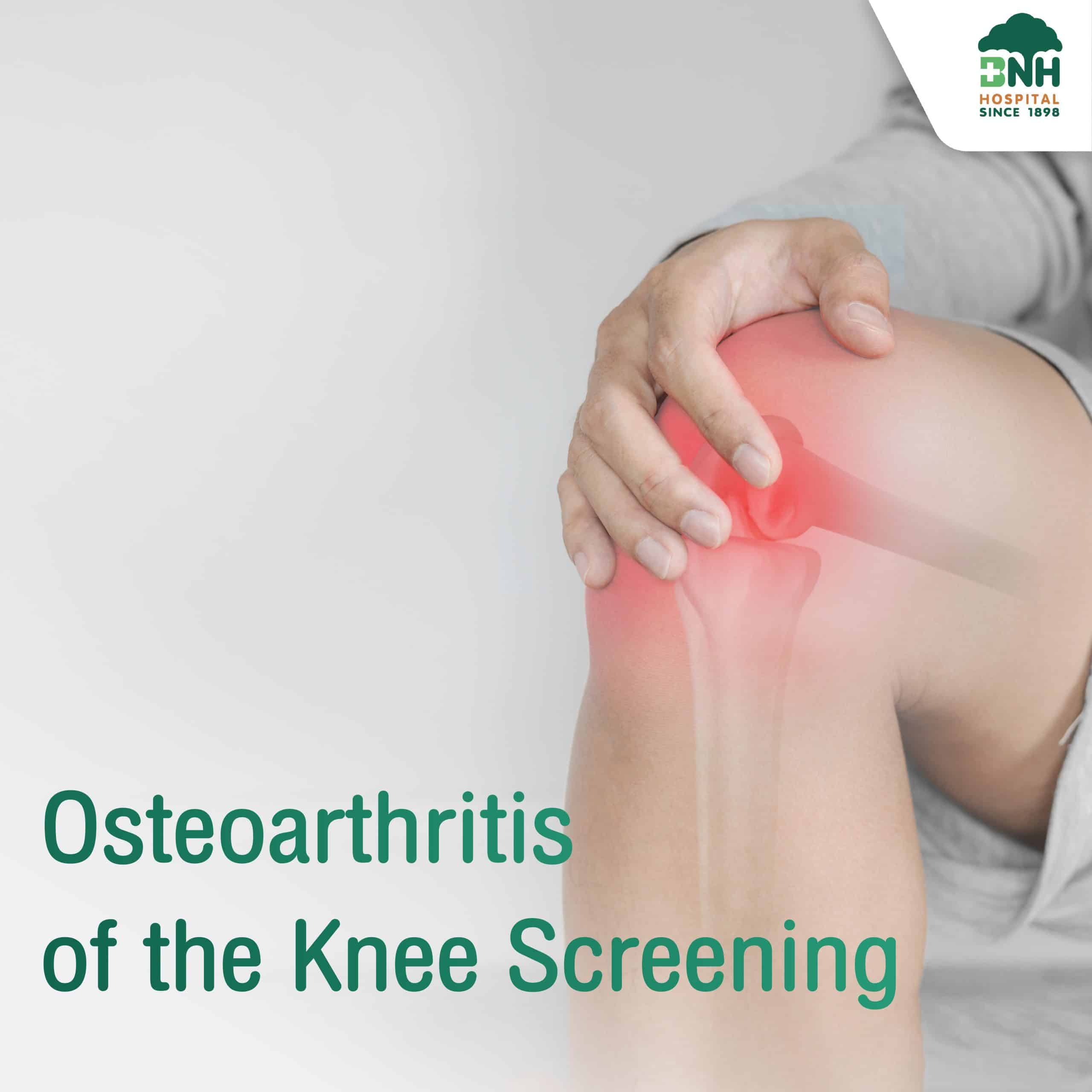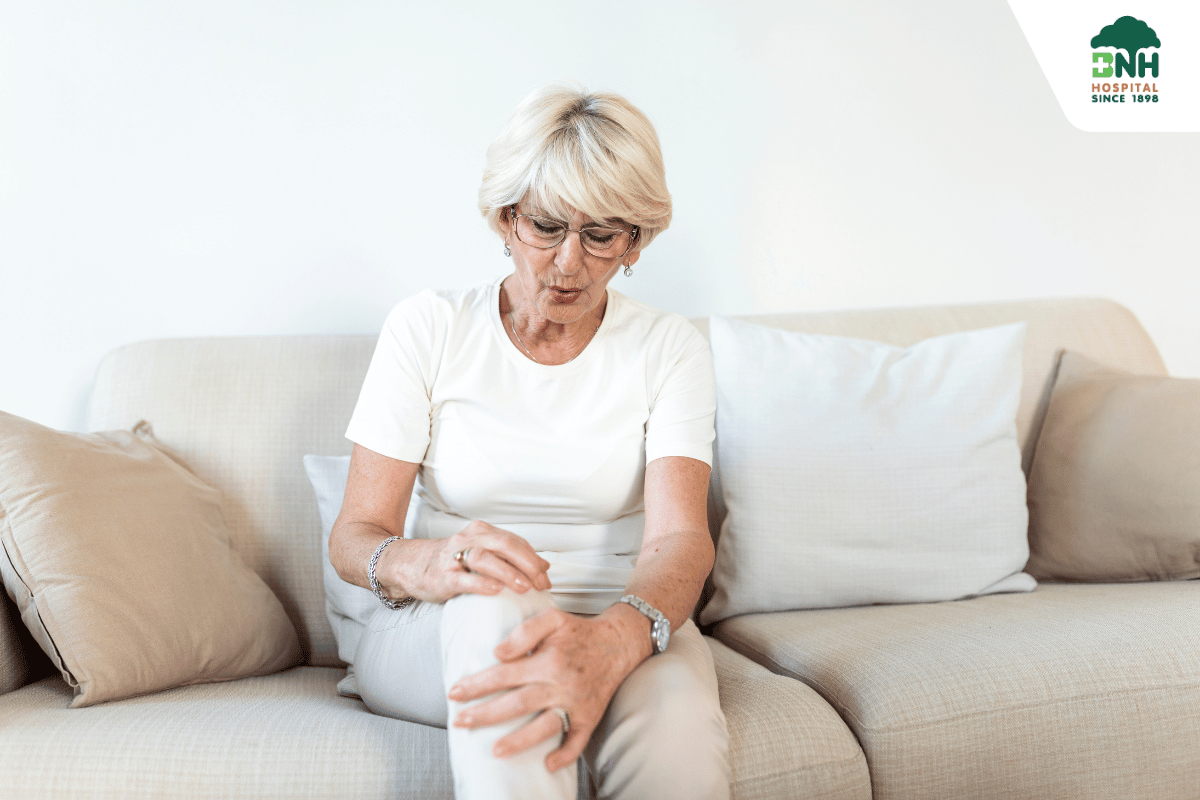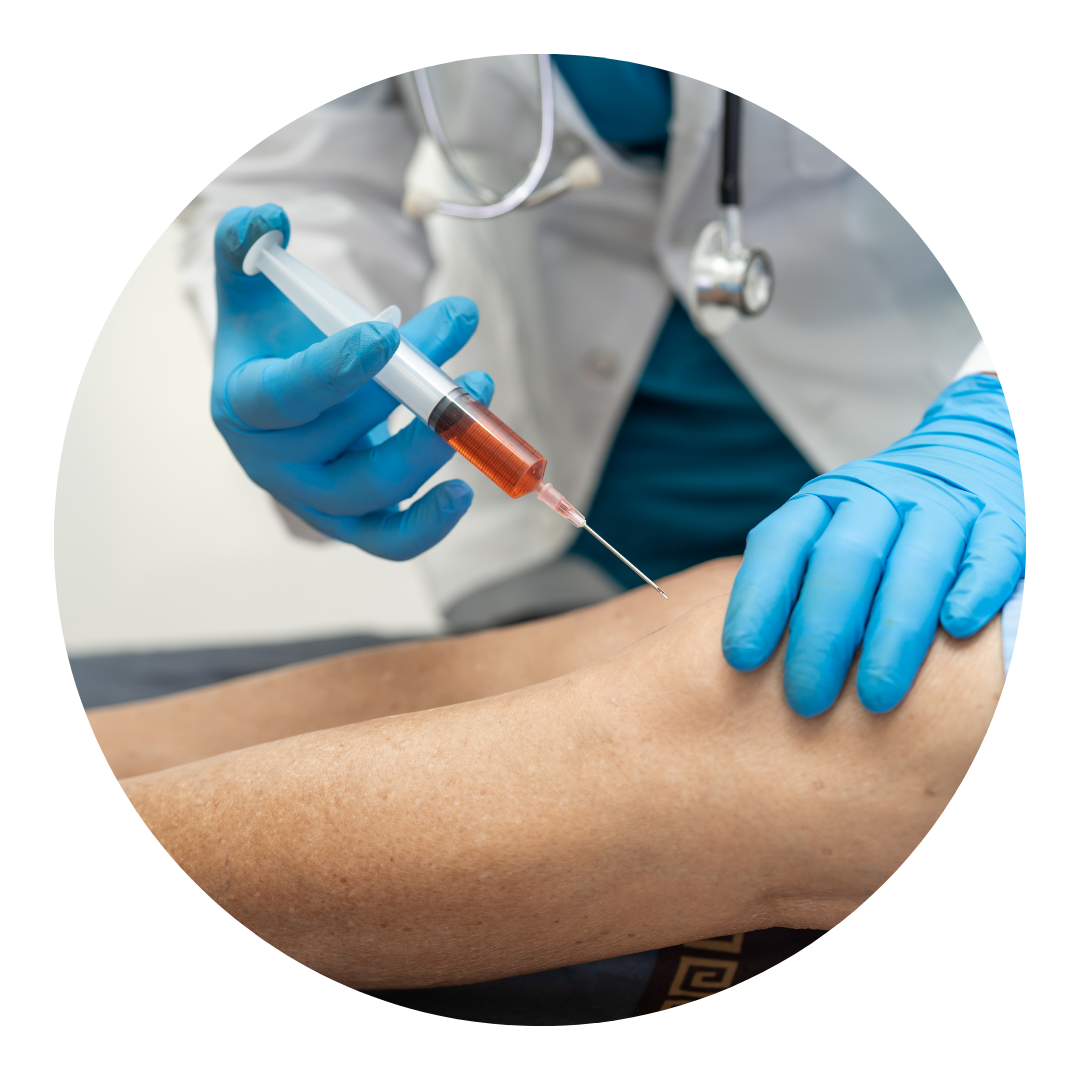Comprehensive Orthopaedics Centre @BNH Hospital
For the most effective and safest treatment
By a team of highly experienced specialists
Osteoarthritis
Symptoms of Osteoarthritis
- Symptoms of osteoarthritis in the early stages may not be noticeable, but patients often feel stiffness in the knee or twisting in the joint from time to time, especially after being stationary or when a joint has been in one position for too long.
- In later stages, the pain gradually becomes more apparent. The disease process can take months or even years.
- In later stages, joint stiffness becomes more frequent and more pronounced, and there may be a squeaking sound, similar to the sound of rubbing sandpaper. At this stage, patients often experience pain, which may be completely different for each patient, such as mild pain, sometimes severe pain, or constant pain. When observed carefully, the pain may be associated with a specific activity, such as vigorous exercise, climbing stairs, sitting or squatting, and it is often observed that the severity of pain improves when these activities are reduced. Some patients may feel pain relocating or increasing in a particular area of the joint to other parts of the body.
- The pain that occurs leads some patients to adjust their movements by not extending or fully flexing the knee joint over time, which causes joint stiffness and dislocation of the knee flexion.
- Some patients with osteoarthritis may experience swelling and warmth in the knee, where the skin may become dark red or have bony protrusions in the joint, indicating that the knee joint is enlarged and joint mobility is more restricted. Inflammation in large, weight-bearing joints can make it difficult for the patient to walk underweight because of the pain.

Who should be screened for knee osteoarthritis?
Osteoarthritis may not happen to everyone, but people with the following factors are at higher risk:
- Aging
- Female
- Obesity (BMI>25)
- Repetitive or excessive impact to joints
- Heredity
- Fractured bones from accidents
- Arthritis
- Abnormalities in the joint area

Protecting Knee Health for Sports Enthusiasts: The Importance of Knee Screening Tests
For individuals who are passionate about sports and frequently engage in activities that heavily involve their knees, maintaining knee health is paramount. The knees play a crucial role in athletic performance, and the repetitive stress placed on them during sports activities can increase the risk of knee problems.
One effective way to protect and prevent knee problems is through knee screening tests. These tests allow athletes to assess the condition of their knees and identify any potential issues early on. Here are some key steps for sports enthusiasts to protect their knee health through knee screening tests:
Regular Screening: Athletes should schedule regular appointments with a healthcare professional for knee screening tests. These screenings can help evaluate the overall health of the knees and assess the risk of developing knee problems.
Injury Prevention: Wearing appropriate protective gear, such as supportive footwear and knee braces, can help reduce the risk of knee injuries during sports activities. Additionally, practicing proper techniques and warming up before exercise can further prevent knee injuries.
Strength and Flexibility Training: Incorporating strength and flexibility exercises into a regular workout routine can help strengthen the muscles around the knee joint and improve flexibility. Stronger muscles provide better support for the knee, reducing the risk of injuries.
Rest and Recovery: Adequate rest and recovery are essential for preventing overuse injuries and allowing the knees to heal after intense physical activity. Athletes should prioritize rest days and listen to their bodies to avoid pushing themselves too hard.
Prompt Treatment: If any knee pain or discomfort arises during or after sports activities, athletes should seek prompt medical attention. Early diagnosis and treatment of knee problems can prevent them from worsening and facilitate a quicker recovery.
By incorporating knee screening tests into their routine and following these preventive measures, sports enthusiasts can effectively protect their knee health and continue enjoying their favourite activities with reduced risk of injury.
Contact us or Make an appointment

Osteoarthritis of the Knee Screening by BNH Hospital
Examination List
- Physical examination by an osteoarthritis specialist
- X-ray of both knees (front and side)
Remarks
- This package includes doctor fee and hospital services fee.
- Expenses for additional consultations or treatments, other than those included in the package, such as doctor fees, medications, procedures, or equipment, are not included.
- This package is for 1 examination only.
- Please make an appointment prior to using the service
- For more information, please call: 02-022-0700 Ext. 2775-2776.
BMI Calculator
BMI Calculator
Symptoms of Osteoarthritis
- Symptoms of osteoarthritis in the early stages may not be noticeable, but patients often feel stiffness in the knee or twisting in the joint from time to time, especially after being stationary or when a joint has been in one position for too long.
- In later stages, the pain gradually becomes more apparent. The disease process can take months or even years.
- In later stages, joint stiffness becomes more frequent and more pronounced, and there may be a squeaking sound, similar to the sound of rubbing sandpaper. At this stage, patients often experience pain, which may be completely different for each patient, such as mild pain, sometimes severe pain, or constant pain. When observed carefully, the pain may be associated with a specific activity, such as vigorous exercise, climbing stairs, sitting or squatting, and it is often observed that the severity of pain improves when these activities are reduced. Some patients may feel pain relocating or increasing in a particular area of the joint to other parts of the body.
- The pain that occurs leads some patients to adjust their movements by not extending or fully flexing the knee joint over time, which causes joint stiffness and dislocation of the knee flexion.
- Some patients with osteoarthritis may experience swelling and warmth in the knee, where the skin may become dark red or have bony protrusions in the joint, indicating that the knee joint is enlarged and joint mobility is more restricted. Inflammation in large, weight-bearing joints can make it difficult for the patient to walk underweight because of the pain.

How do I know if it's Osteoarthritis?
Visiting a doctor for a physical exam, as well as a radiographic examination, can help confirm if you have osteoarthritis.
Abnormalities that occur when it comes to Osteoarthriti
- The surface of the knee joint, which is cartilage, begins to deepen or makes the joint surface uneven, loses its smoothness, lubrication, and glossiness of the cartilage surface, causing joint movement to become stuck, stiff, or make a noise like rubbing sandpaper.
- The weight distribution of the articular surface is abnormal, as some areas carry more weight while others less, causing abnormally overloaded areas, rapid wear, and tingling pain.
- The membranes are irritated by fragments of cartilage within the joint, producing more inflammatory substances and producing more water in the joint, but of poor quality, causing pain, swelling, and warmth in the knee.
- Muscles around the knee joint: Due to the pain and inflammation of the knee joint, the patient uses the diseased leg less, resulting in less strength in the muscles around the knee joint. So when walking underweight, there is more impact on the joint surface.
- Some of the ligaments in the joints begin to sag as a result of the degeneration of that articular cartilage. As the ligaments stretch, the joints sway or become looser, thus causing more abnormal movement, whereby the knee to deteriorate faster.
- Leg axis: As a result of the ligaments sagging and the cartilage surface wearing out, the joint begins to oscillate in a more irregular direction, and when the patient’s weight increases, it encourages the ligaments to sag and makes the legs look more deformed, such as buckling or sagging in the degenerative knee. The body will gradually build up bone growth within the joint to help the bone around the knee joint to adjust to the more stable movement, which can lead to less flexion movement and thinner bone density in and around the joint, as most patients begin to walk less.

PRP: A Non-Surgical Approach to Reduce Pain from Osteoarthritis
PRP (Platelet Rich Plasma)
is a treatment aimed at alleviating pain from injuries or chronic inflammation related to osteoarthritis, tendons, muscles, bones, and soft tissues by injecting concentrated platelets from the patient’s own blood back into the injured area, providing an alternative to surgery.

“When osteoarthritis enters the final stage, the most effective treatment is knee replacement surgery, as it allows patients to recover from the pain and resume their daily lives.”

Here's how BNH Hospital can help you regain an active life:
Advanced Pain Management Techniques: One of the biggest concerns patients have about surgery is pain. At BNH Hospital, our experienced medical team utilizes innovative pain management protocols, especially special nerve block techniques to ensure maximum comfort during your hospital stay and recovery period at home.
Minimally Invasive Surgical Techniques: We employ modern surgical approaches that utilize smaller incisions and specialized tools, resulting in faster recovery times and less post-operative pain.
- Total Knee Arthroplasty (TKA): This procedure replaces the entire damaged knee joint with prosthetic components, ideal for patients with severe osteoarthritis who haven’t found relief through other means.
- Unicompartmental Knee Arthroplasty (UKA): This partial knee replacement targets only the damaged portion of the joint, suitable for patients with arthritis limited to one side of the knee and a healthy patella (kneecap).
Experienced Surgical Team: Our highly qualified orthopaedic surgeons have extensive experience performing successful knee replacements, ensuring optimal results and personalized care.
Contact to inquire or make an appointment.
FAQ by medical professionals

Osteoarthritis treatment is highly recommended because knee joint degeneration is a spontaneous condition that occurs as we age, similar to the onset of wrinkled skin. Patients with osteoarthritis of the knee experience physical disabilities, especially pain and the inability to perform daily tasks, which requires treatment. The goal of osteoarthritis treatment is to reverse the overall condition and relieve pain by strengthening the muscles surrounding the joint, and to keep the joint functioning to a satisfactory level, where you can exercise and perform daily activities that are appropriate for your age and condition.
If the doctor determines that a patient has osteoarthritis of the knee, but does not have any unusual symptoms, no special treatment may be necessary. In this case, the patient can preserve or maintain the deteriorated joint such that it can remain as is without causing further problems for as long as possible.
For patients with osteoarthritis of the knee with mild symptoms, the main treatment is control of the inflammation so that it does not interfere with daily life, by adjusting the knee function pattern, exercising, which strengthens your muscles, and preventing further inflammation, which slows the deterioration and wear & tear of the joints.
Nowadays, many patients with osteoarthritis of the knee prefer to take Glucosamine, a dietary supplement that does not cause any harm over the long term. Most doctors are of the opinion that if patients take these substances and their knee joint symptoms improve, they can continue to take them.

Osteoarthritis of the knee is a multifactorial condition, but it is generally associated with other joint degeneration, especially the spine and hip and weight-bearing joints, depending on the usage of the individual, including in the case where the knee joint has been deformed over a long period of time. This may place a greater burden on other joints, causing further deteriorate as well.

Generally, knee supports can help reduce pain during injury or inflammation by making the knee joints firmer and more stable. However, wearing supports for a long period of time will result in less exertion of the muscles, causing more weakness, which can result in the muscles supporting the front and back of the knees becoming less effective. Therefore, it is recommended to wear them temporarily, only to relieve pain, but not to prevent osteoarthritis.

In older people whose bone density begins to decline, taking calcium can help strengthen bones and reduce the pressure on their joints, which can slow down the onset of osteoarthritis.
At present, there are no empirical scientific data on herbs can treat osteoarthritis.
Experiences from patients
“Did a short 15K ride in Bangkachao this morning on my low-step bike. Easier to mount and dis-mount. After all, I am not 75 anymore as my wife told me.
Thank you to you and your teams for a super job, getting me to this point only 7 weeks after to my knee replacement surgery.”
“I have been using BNH for 35 years and have always been impressed by the standard and medical care – but todays experience was totally outstanding; efficient, professional, and caring by all staff but particularly nursing and support staff; and of course by Dr Worapoj who’s treatment – medical assessment and diagnosis; explanation and bedside manner was world class… very many thanks. “
SPECIALIST
-

นพ. ชินดนัย หงสประภาส
ศูนย์กระดูกและข้อครบวงจร
ความชำนาญพิเศษ: ออร์โธปิดิกส์ ( Orthopedic Surgery )
-

นพ. จิรันดร์ อภินันทน์
ศูนย์กระดูกและข้อครบวงจร
ความชำนาญพิเศษ: ศัลยกรรมกระดูก
-

รศ. นพ. ณพชาติ ลิมปพยอม
ศูนย์กระดูกและข้อครบวงจร
ความชำนาญพิเศษ: ศัลยกรรมกระดูก / หัวไหล่และข้อ
-

นพ. นราพงษ์ หังสพฤกษ์
ศูนย์กระดูกและข้อครบวงจร
ความชำนาญพิเศษ: ศัลยกรรมหัวไหล่และข้อ
-

นพ. ภพ เหลืองจามีกร
ศูนย์กระดูกและข้อครบวงจร
ความชำนาญพิเศษ: ศัลยกรรมกระดูก/หัวไหล่และศัลยกรรมทางมือและจุลศัลยกรรม
-

นพ. ยติธร เพ็ญชาติ
ศูนย์กระดูกและข้อครบวงจร
ความชำนาญพิเศษ: ศัลยกรรมกระดูก
-

นพ. วรพจน์ หงสเลิศพิภพ
ศูนย์กระดูกและข้อครบวงจร
ความชำนาญพิเศษ: ศัลยศาสตร์ออร์โธปิดิกส์
-

รศ. นพ. วัชระ วิไลรัตน์
ศูนย์กระดูกและข้อครบวงจร
ความชำนาญพิเศษ: ศัลยกรรมกระดูก / หัวไหล่และข้อ
-

นพ. ศรัณย์ ตันติ์ทวิสุทธิ์
ศูนย์กระดูกและข้อครบวงจร
ความชำนาญพิเศษ: Traumatic and Arthroplasty
-

รศ. นพ. สมศักดิ์ คุปต์นิรัติศัยกุล
ศูนย์กระดูกและข้อครบวงจร
ความชำนาญพิเศษ: ศัลยกรรมกระดูก / หัวไหล่และข้อ
-

นพ. สุเมธ สุรัฐการดาวดี
ศูนย์กระดูกและข้อครบวงจร
ความชำนาญพิเศษ: Arthroscope , Orthopaedics , Spine
-

นพ. อารักษ์ ลิ่มตระกูล
ศูนย์กระดูกและข้อครบวงจร
ความชำนาญพิเศษ: ศัลยศาสตร์ออโธปิดิกส์
Contact to inquire or make an appointment.

Osteoarthritis of the Knee Screening by BNH Hospital
Examination List
- Physical examination by an osteoarthritis specialist
- X-ray of both knees (front and side)
Remarks
- This package includes doctor fee and hospital services fee.
- Expenses for additional consultations or treatments, other than those included in the package, such as doctor fees, medications, procedures, or equipment, are not included.
- This package is for 1 examination only.
- Please make an appointment prior to using the service
- For more information, please call: 02-022-0700 Ext. 2775-2776.



